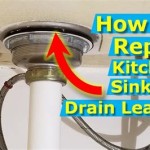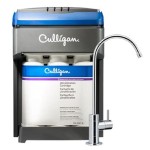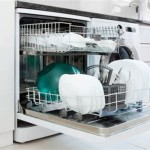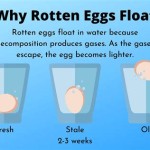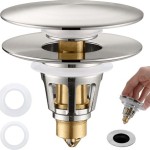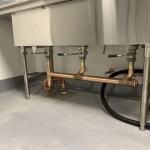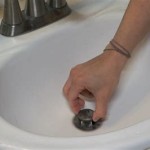Here's an article focusing on inline water filter under sink systems, designed to be informative and professional:
Inline Water Filter Under Sink: A Comprehensive Guide
Inline water filter systems installed under the sink represent a practical and increasingly popular solution for improving the quality of drinking water in residential and commercial settings. These systems offer a discreet and efficient way to remove contaminants, providing cleaner, better-tasting water directly from the kitchen faucet.
Unlike larger whole-house filtration systems, under-sink filters target the water supply specifically for drinking and cooking, minimizing the impact on water pressure throughout the rest of the plumbing. This localized approach makes installation straightforward in many cases and reduces the overall cost compared to more comprehensive filtration solutions.
Understanding the Mechanics of Inline Water Filters
Inline water filters operate on a simple but effective principle: water is forced through a filter medium, which traps or removes unwanted particles, chemicals, and microorganisms. The filter is connected directly to the cold water line under the sink, typically between the shut-off valve and the existing faucet. When the cold water tap is turned on, water flows through the filter before reaching the faucet.
The effectiveness of an inline filter depends largely on the type of filter medium used. Common types include:
*Sediment Filters:
These remove particulate matter such as sand, silt, rust, and other debris that can cloud water and affect its taste. Sediment filters protect downstream filters from clogging and improve their overall efficiency. *Activated Carbon Filters:
Activated carbon is highly effective at removing chlorine, chloramine, volatile organic compounds (VOCs), and other chemicals that impart unpleasant tastes and odors to water. Carbon filters work by adsorbing these contaminants onto their porous surface. *Carbon Block Filters:
Similar to activated carbon filters, carbon block filters are made from compressed carbon particles, offering a greater surface area and therefore a higher contaminant removal rate. They are particularly effective at removing lead, asbestos, and other heavy metals. *Reverse Osmosis (RO) Filters:
While often part of a multi-stage system, RO filters can be incorporated into inline configurations. They use a semi-permeable membrane to remove a wide range of contaminants, including dissolved salts, minerals, and microorganisms. However, RO systems typically require a separate storage tank and faucet due to the slower filtration rate. *Specialty Filters:
Some inline filters are designed to target specific contaminants, such as fluoride, arsenic, or bacteria. These filters often employ specialized media like ion exchange resins or catalytic materials.The filter's lifespan is determined by the volume of water filtered and the concentration of contaminants. Most manufacturers recommend replacing filters every 6 to 12 months, although this may vary depending on water quality and usage. Regular filter replacement is crucial to maintain optimal performance and prevent the filter from becoming a breeding ground for bacteria.
Key Advantages of Inline Water Filter Under Sink Systems
Inline under-sink water filters offer several advantages over other filtration methods, making them a compelling choice for many households:
*Improved Water Quality:
The primary benefit is the significant improvement in water quality. By removing chlorine, sediment, and other impurities, these filters provide cleaner, better-tasting drinking water. This can lead to increased water consumption and improved hydration. *Cost-Effectiveness:
Compared to purchasing bottled water, an under-sink filter is a cost-effective long-term solution. The initial investment is relatively low, and the ongoing cost of filter replacements is significantly less than the expense of bottled water. *Convenience:
Having filtered water on demand directly from the kitchen faucet is incredibly convenient. There is no need to fill pitchers or install countertop filters, saving time and effort. *Space-Saving Design:
Under-sink filters are compact and discreet, taking up minimal space under the sink. They do not clutter the countertop or require a dedicated water dispenser. *Easy Installation and Maintenance:
Most inline filters are relatively easy to install, often requiring only basic plumbing skills. Filter replacements are also simple and straightforward. *Reduced Environmental Impact:
By eliminating the need for bottled water, under-sink filters help reduce plastic waste and its associated environmental impact.The specific advantages will also vary, depending on the local water supply. For example, individuals in areas with hard water may find that filtration reduces scale buildup in appliances, while those with concerns about lead contamination will benefit from a filter's ability to remove heavy metals.
Factors to Consider When Choosing an Inline Water Filter
Selecting the right inline water filter requires careful consideration of several factors to ensure it meets specific needs and preferences:
*Water Quality:
The first step is to understand the quality of the local water supply. A water test can identify the specific contaminants present and their concentrations. This information will help determine the type of filter medium needed. Home water testing kits are available or a sample can be sent to a certified laboratory for analysis. *Filter Capacity:
The filter capacity refers to the amount of water it can effectively filter before needing replacement. This is typically measured in gallons or liters. Consider the household's water consumption to choose a filter with an appropriate capacity. *Flow Rate:
The flow rate indicates how quickly water can pass through the filter. A low flow rate can result in a weak stream of water, which can be inconvenient. Choose a filter with a flow rate that meets the household's needs. The flow rate is usually listed in gallons per minute (GPM) or liters per minute (LPM). *Filter Cartridge Type and Availability:
Ensure that replacement filter cartridges are readily available and affordable. Some filters use proprietary cartridges that can be expensive or difficult to find. *System Certification:
Look for filters that are certified by independent organizations such as NSF International or the Water Quality Association (WQA). Certification indicates that the filter has been tested and meets industry standards for contaminant removal. *Installation Requirements:
Consider the complexity of installation and whether professional assistance is needed. Some filters are designed for DIY installation, while others may require a plumber. Check the specific tools need to install the filter before purchasing the kit. *Budget:
Inline water filters range in price from relatively inexpensive to more costly models. Set a budget and choose a filter that offers the best value for the price. *Warranty:
Consider the warranty offered by the manufacturer. A longer warranty provides peace of mind and indicates confidence in the product's quality. *Ease of Filter Replacement:
Filters need to be replaced periodically, so ensure that this is a simple system to use.Considering these factors will help you choose an inline water filter. It will allow you to select one that effectively addresses specific water quality concerns, meets the household's needs, and fits within the budget.
In conclusion, inline water filter systems provide an efficient and convenient method for purifying drinking water directly from the tap. By understanding the different types of filters available and carefully assessing both water quality and the specific needs of the household, informed decisions can be made in selecting the optimal system. With straightforward installation and maintenance, these systems offer lasting improvements to water quality, promoting health and well-being while minimizing environmental impact and costs.

High Flow Inline Undersink Water Filter System Made In Usa

Under Sink Water Filters Are They A Good Investment Paragon Systems

Westbrass Under Sink In Line Water Filter Unit And Cartridge For Instant Hot Or Pure Dispenser Faucets White F400

Ispring 4 Stage Inline Drinking Water Filter Model Cu A4 Gac Under Sink Filtration System In The Systems Department At Com

Frizzlife Inline Water Filter System For Refrigerator Ice Maker Unde

3 8 Quick Change 1 Stage Under Sink Water Filter System Nu Aqua

Aquacrest 5kdc Inline Water Filter For Under Sink Refrigerator Ice Maker Stainless Steel Hose Direct Connect Fittings

Aquasure Fortitude Compact Under Sink Multi Purpose Water Filtration With Carbon Kdf Reduces Chlorine Lead Taste And Odor As Fc50h Ck

6 Stage Alkaline Under The Sink Reverse Osmosis Drinking Water Filter System 50 100 Gpd

Installing An Under Sink Water Filter Fine Homebuilding

